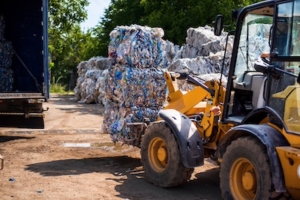The dynamic field of HDPE recycling serves as a key component in the global challenge to effectively manage our escalating plastic waste crisis. Current practices incorporate diverse stages of sorting, cleaning, and reprocessing, riddled with multiple efficiencies and hurdles.
These have huge implications for the environment, influenced not just by the actual recycling operations, but also the regulatory framework that governs them. As we delve deeper to understand the environmental footprint of HDPE recycling, we must also look ahead, considering the emerging innovations in this field.
Biotechnological methods, chemical recycling, and the advent of artificial intelligence are beginning to reshape the industry, pressing us to weigh their scalability and anticipated impacts. This broad overview is an important step towards becoming informed on the future of HDPE recycling, a topic that concerns us all.
Current HDPE Recycling Techniques
High-Density Polyethylene (HDPE)
is a vital part of the modern world. It finds extensive use in manufacturing containers, piping systems, bottles, and a myriad of other products due to its hardy and flexible properties, not to mention its resistance to many chemicals.
Given this ubiquity, it is essential to understand the intricacies of recycling HDPE, which, if done effectively, can significantly reduce environmental impact.
Recycling Methods for HDPE
Recycling HDPE typically involves three established methods. These include primary (or mechanical) recycling, secondary recycling, and tertiary (or chemical) recycling, each of these methods having varying degrees of efficiency.
Primary Recycling
Primary recycling – the most common recycling method – involves mechanically processing the plastic waste into new products. The process begins with the collection of HDPE waste, followed by washing to remove contaminants. It is then shredded and melted before being extruded into pellets which are subsequently reused to manufacture other plastic goods.
As efficient as it is, primary recycling is not without its drawbacks. The process cannot remove all impurities from HDPE waste. Impurities left in the recycled material may reduce the quality of the final product, which limits the potential applications of recycled HDPE.
Secondary Recycling
On the other hand, secondary recycling transforms plastic waste into liquid or gaseous fuels, such as diesel. In this method, HDPE is heated without oxygen in a process known as pyrolysis. This results in the production of oil and gas which can be refined into various types of fuels.
While secondary recycling can convert all HDPE waste into energy sources without leaving any residual matter, it is a less cost-effective method than primary recycling. Moreover, not all output from secondary recycling can be used for fuel as some of it needs to be treated as waste.
Tertiary Recycling
Tertiary recycling, also known as chemical recycling, breaks down the long chains of polymers into their constituting monomers using chemicals or catalysts. These monomers can then be purified and polymerized to create new plastic products of virtually the same quality as the original material.
Despite its efficiency in producing high-quality recycled HDPE, chemical recycling is currently not economically viable for large-scale use due to its high energy requirement and cost of the required chemicals or catalysts.
Recycling HDPE is no doubt a vital aspect of the modern waste management landscape, and further strengthening of these established methods will play a significant role in protecting our environment. Future research will inevitably continue to refine these methods, possibly by improving the efficiency of mechanical recycling or the cost-effectiveness of chemical recycling. With every refinement, the preservation of our planet becomes more and more achievable.

Environmental Implications of HDPE Recycling
Understanding the environmental implications of the modern recycling techniques of high-density polyethylene (HDPE) requires peeling back the commonly accepted narrative. To examine this oft-underappreciated aspect of HDPE recycling, one must delve deeper into the ramifications for energy usage, contamination, greenhouse gas emissions, and impact upon water resources.
Energy Utilization
Energy utilization is a critical consideration for recycling processes. The energy expenditure of primary recycling – where HDPE is collected, washed, shredded, extruded into pellets, and then re-purposed – is significant. For secondary and tertiary recycling, where HDPE is converted into fuels or chemically reconstituted, the energy costs are high.
Current studies indicate that the energy consumed by these two processes is competitive with the production of new plastics, and in some cases, even exceeds it. Thus, the widely-acclaimed understanding that recycling conserves energy is questionable.
Chemical Contamination
Chemical contamination is another alarming issue associated with HDPE recycling. Even though the steps followed in primary recycling are essentially meant to weed out impurities, it is impossible to completely remove them. As such, the recycled materials often contain contaminants. Traces of these impurities often prove to be harmful to human health and the environment. This is also true for secondary and tertiary recycling, where the process itself can lead to chemical contamination.
Greenhouse Gas Emissions
Greenhouse gas emissions constitute another environmental burden associated with HDPE recycling. Image this scenario. A single shipment of HDPE waste makes a round trip from its source to a recycling facility and then to its point of use as a recycled product. The cumulative fuel consumption of this transportation results in significant greenhouse gas emissions, thereby contributing to global warming.
Finally, among the least considered but significant environmental determinants is the impact on water resources. Industrial cleaning, a key step in primary recycling, requires enormous quantities of water. Moreover, the washing process often discharges contaminated wastewater into rivers and seas, thus impacting aquatic ecosystems negatively.
In sum, a holistic examination of environmental implications cannot ignore acknowledging the true costs imposed by current HDPE recycling practices – energy consumption, contamination, greenhouse gas emissions, and water resource depletion. This compels us to reconsider our perception of recycling, calling for a keen pursuit of innovative and transformative solutions.
Rather than being content with cosmetic efforts, we must recognize the complexity of recycling, the need for genuine research, and the importance of refining our current practices toward sustainability. Undoubtedly, this is driven by an unwavering commitment to adopting an environmentally conscious trajectory for our HDPE recycling.

Innovations in HDPE Recycling
As HDPE recycling continues to evolve, new technologies and methodologies are taking the forefront in revolutionizing the environment-friendly disposal and reuse of HDPE waste. Amidst ever-increasing global waste concerns, these emerging strategies promise a significant impact on the future of HDPE recycling.
Nanotechnology-Based Recycling
One key innovative area is nanotechnology-based recycling, where nanomaterials are used to enhance the recycling process. In particular, the use of nanoparticles shows great promise in contaminant removal during recycling, addressing the long-standing problem of impurities in primary recycling.
These tiny particles, no more than a few billionths of a meter in size, are capable of binding with foreign contaminants in HDPE, aiding in their efficient removal. This cutting-edge technique has the potential to increase the quality of recycled HDPE products, thus making recycling a more viable alternative to new plastic manufacturing.
Advanced Thermal Techniques
Next, due to limitations posed by mechanical and chemical recycling methods, advanced thermal techniques like gasification and steam cracking are emerging as potential players in the recycling sector. Through gasification, HDPE waste is converted into synthetic gas or “syngas”, with immense potential as an energy source.
Steam cracking, on the other hand, harnesses steam to break down polymers into simpler, reusable products. Both methods offer several substantial advantages, including lower greenhouse gas emissions and higher energy efficiency when compared to traditional techniques.
Biotechnological Approaches
In addition, the advent of biotechnological approaches has added a new facet to HDPE recycling. Certain microorganisms, such as fungi and bacteria, demonstrated an ability to naturally degrade HDPE, which could revolutionize the entire process of HDPE recycling. This bio-based recycling process is still in the experimental stage, but if successful, it could provide a sustainable and environment-friendly method to manage HDPE waste.
Digital Technology
Developments in digital technology, notably the Internet of Things (IoT) and Artificial Intelligence (AI), are showing promise in streamlining HDPE recycling. These technologies could optimize the sorting and separating processes, improve predictive maintenance of recycling machinery, optimize energy utilization, and even identify contamination in real-time.
Recycling technologies like these, charting new paths, are key to addressing the persisting issues with HDPE recycling. The diversification and advancement of these techniques can potentially simplify and streamline the process, bringing us a step closer to curing the plastic waste epidemic.
As the field of HDPE recycling continues to grow and advance, these pioneering solutions are on a path to dramatically reduce environmental impact and facilitate a sustainable future.
Regulatory Frameworks and Policies Shaping HDPE Recycling
The unifying thread moving forward becomes the issue of regulatory policies and frameworks that are shaping the future of HDPE recycling.
Regulating Policies and Frameworks
Regulating policies serve as defining parameters in the recycling domain, signaling the preferred direction for development. To illustrate, the recent emphasis on Extended Producer Responsibility (EPR) schemes demonstrates a conscious shift towards making manufacturers more accountable for the afterlife of their products.
Under EPR, manufacturers are encouraged, and in some instances obligated, to reduce environmental harm from their products by prompting more sustainable design and production practices. In the context of HDPE recycling, this can translate to designing HDPE products with recycling in mind, thereby enhancing recyclability and reducing impurities.
This regulatory phasing towards sustainability and corporate accountability is embracing the concept of a circular economy. Encouraging increased recycling, decreasing waste production, and reducing reliance on raw materials are all aspects of this model. These eco-conscious philosophies embedded within regulations push for better HDPE recycling methodologies and technologies.
Furthermore, a strict regulatory framework can stimulate research and development in HDPE recycling. Permitting guidelines controlling the level of contaminants in recycled HDPE, for instance, can push for the adoption of nanotechnologies and biotechnological approaches.
Similarly, the imposition of greenhouse gas emission standards can drive the advancement of energy-efficient recycling techniques and the use of renewable energy sources in the recycling process.
Case Studies on HDPE Recycling
Let’s take Europe as an example, where the regulatory landscape has embraced the principles of the circular economy through the European Waste Framework Directive. The Directive mandates member states to take necessary steps to ensure waste is recovered and recycled.
Additionally, the European Plastics Strategy aims to ensure that all plastic packaging in the EU market will be reusable or easily recyclable by 2030. These strict regulations have spurred advances in recycling technologies, including HDPE recycling, and are pushing the industry towards more sustainable practices.
In the United States, the recycling policy framework varies from state to state. Nonetheless, states such as California are leading with robust recycling regulations. The California Bottle Bill, for instance, provides consumers with a financial incentive to recycle, subsequently boosting the collection and recycling of plastics, including HDPE.
These regulatory policies and frameworks, enriched by technologically forward methods and bolstered by a broader systemic view, can drive accelerated progress in HDPE recycling. Moreover, when these rules are underpinned by core sustainability principles such as reducing energy usage, minimizing carbon footprint, preserving water resources, and reducing waste generation, the result is an environmentally sound recycling ecosystem.
To conclude, regulations and policies, crafted wisely and executed diligently, are instrumental pieces of the puzzle in the quest for achieving sustainable HDPE recycling. With a future that’s likely to hold more stringent rules and increased corporate accountability, the trajectory of HDPE recycling, and indeed of waste management as a whole, is being aligned with the overarching need for environmental preservation and sustainability.
HDPE Recycling: Final Thoughts
As the discussion reveals, the encompassing realm of HDPE recycling is traversing an exciting yet challenging course. While constant advancements are being made in the industry, the inherent environmental implications associated with inefficient recycling underscore the need for a comprehensive and globally accepted strategy.
Key to the future of this segment is also the regulatory framework, policies, and legislation that can effectively guide it on a global scale. Innovations driving the sector, whether they emerge from biotechnological advancements, chemical recycling, or artificial intelligence, must be clearly understood and implemented responsibly.
Such a multi-pronged approach will ensure that HDPE recycling becomes a sustainable element of our global waste management system, a system that must increasingly embrace circular economics principles to fully tackle our global plastic waste predicament.





